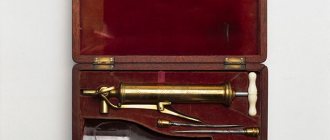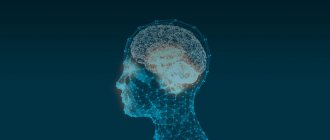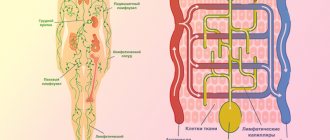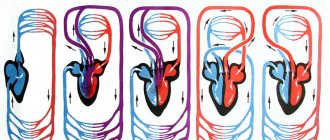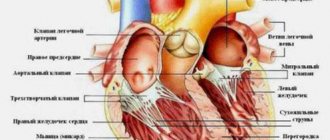William Harvey: discovery of the body's circulatory system
On April 16, 1618, the English scientist and physician William Harvey first presented a new view of the circulatory system in the human body. William Harvey is considered the founder of physiology and embryology. During his research activities, he conducted a sufficient number of experiments, concurrently acting as a lecturer at the Lamlian Readings in order to improve the level of medical education in London. William Harvey gave a full course of lectures on anatomy, surgery and medicine in general.
During his next public lecture, William Harvey openly stated that he had conducted a series of experiments that allowed him to make discoveries: blood moves in a circle, or, more precisely, in two circles: a small one through the lungs, and a large one through the entire body. That is, the scientist argued that the heart of humans and animals is a pump that pumps blood through the arteries into the tissues. He explained this process this way: blood circulates inside the body, returning back to the heart through the veins, it passes through the lungs to receive oxygen from them, and only then returns to the tissues. And so on in a circle. This is a continuous process of blood circulation in the body.
Source - William Harvey first outlined his view on the problem of blood circulation
William Harvey demonstrates his theory of blood circulation in the body
Source - Wikipedia
Then Harvey’s discovery was met with a barrage of criticism from scientists who adhered to the views of Aristotle and Galen that blood is formed in the liver from food and moves through veins that blindly end in the organs. But still, William Harvey achieved recognition of his discovery among medical scientists during his lifetime. In 1628, in Frankfurt, an English scientist published a scientific work, “An Anatomical Study on the Movement of the Heart and Blood in Animals,” in which he formulated in detail the theory of blood circulation, based on his experimental evidence. In addition, after some time, William Harvey came to the conclusion that when a snake bites, the poison spreads through the vein from the site of injury throughout the body, which is definitely dangerous for humans. For English doctors, this insight became the starting point for reflection that led to the development of intravenous injections. In the last years of his life, William Harvey devoted himself to works related to the individual development of animals. As a result of his comparative atomistic and embryological studies, he came to the “conclusion” that “Ex ovo omnia” (“All living things come from the egg”).
The material was prepared from open sources.
Source of image in text - Wikipedia
Image source on the main page - William Harvey first outlined his view on the problem of blood circulation
History of medical discoveries
HISTORY OF MEDICINE: MAIN MILESTONES AND GREAT DISCOVERIES
Based on materials from the Discovery Channel
Medical discoveries have transformed the world. They changed the course of history, saving countless lives, pushing the boundaries of our knowledge to the boundaries where we stand today, ready for new great discoveries.
human anatomy
In ancient Greece, treatment of disease was based more on philosophy than on a true understanding of human anatomy. Surgery was rare, and dissection of corpses was not yet practiced. As a result, doctors had virtually no information about the internal structure of a person. Only during the Renaissance did anatomy emerge as a science.
Belgian physician Andreas Vesalius shocked many when he decided to study anatomy by dissecting corpses. Material for research had to be obtained under the cover of darkness. Scientists like Vesalius had to resort to not entirely legal methods. When Vesalius became a professor in Padua, he became friends with the director of executions. Vesalius decided to pass on the experience gained from years of skillful dissections by writing a book on human anatomy. This is how the book “On the Structure of the Human Body” appeared. Published in 1538, the book is considered one of the greatest works in the field of medicine, as well as one of the greatest discoveries, since it was the first to accurately describe the structure of the human body. This was the first serious challenge to the authority of ancient Greek doctors. The book sold out in huge numbers. It was bought by educated people, even those far from medicine. The entire text is very meticulously illustrated. Thus, information about human anatomy has become much more accessible. Thanks to Vesalius, the study of human anatomy through dissection became an integral part of the training of doctors. And this brings us to the next great discovery.
Circulation
The human heart is a muscle the size of a fist. It beats more than a hundred thousand times a day, over seventy years - that’s more than two billion heartbeats. The heart pumps 23 liters of blood per minute. Blood flows through the body, passing through a complex system of arteries and veins. If all the blood vessels in the human body are stretched out in one line, you get 96 thousand kilometers, which is more than two times the circumference of the Earth. Until the beginning of the 17th century, the process of blood circulation was misunderstood. The prevailing theory was that blood flowed to the heart through pores in the soft tissues of the body. Among the adherents of this theory was the English doctor William Harvey. The workings of the heart fascinated him, but the more he observed heartbeats in animals, the more he realized that the generally accepted theory of blood circulation was simply wrong. He writes unequivocally: “...I wondered if the blood could move as if in a circle?” And the very first phrase in the next paragraph: “Subsequently I found out that this is so...”. While performing autopsies, Harvey discovered that the heart had unidirectional valves, allowing blood to flow in only one direction. Some valves let blood in, others let blood out. And it was a great discovery. Harvey realized that the heart pumps blood into the arteries, then it passes through the veins and, completing the circle, returns to the heart to then begin the cycle all over again. Today this seems like a truism, but for the 17th century, William Harvey's discovery was revolutionary. It was a crushing blow to established ideas in medicine. At the end of his treatise, Harvey writes: “When I think of the countless consequences this will have for medicine, I see a field of almost limitless possibilities.” Harvey's discovery greatly advanced anatomy and surgery, and simply saved the lives of many. All over the world, surgical clamps are used in operating rooms to block the flow of blood and keep the patient's circulatory system intact. And each of them is a reminder of the great discovery of William Harvey.
Blood groups
Another great discovery related to blood was made in Vienna in 1900. All of Europe was filled with enthusiasm for blood transfusions. First there were statements that the healing effect was amazing, and then, a few months later, reports of deaths. Why was the transfusion sometimes successful and sometimes not? Austrian physician Karl Landsteiner was determined to find the answer. He mixed blood samples from different donors and studied the results. In some cases, the blood mixed successfully, but in others it coagulated and became viscous. Upon closer inspection, Landsteiner discovered that blood clots when special proteins in the recipient's blood, called antibodies, react with other proteins in the donor's red blood cells, called antigens. For Landsteiner this was a turning point. He realized that not all human blood is the same. It turned out that blood can be clearly divided into 4 groups, to which he gave designations: A, B, AB and zero. It turned out that blood transfusion is successful only if the person is transfused with blood of the same group. Landsteiner's discovery immediately affected medical practice. A few years later, blood transfusions were performed all over the world, saving many lives. Thanks to the accurate determination of blood type, organ transplantation became possible by the 50s. Today, in the United States alone, a blood transfusion is performed every 3 seconds. Without it, about 4.5 million Americans would die each year.
Anesthesia
Although the first great discoveries in the field of anatomy allowed doctors to save many lives, they could not alleviate the pain. Without anesthesia, operations were a living nightmare. Patients were held or strapped to the table, and surgeons tried to work as quickly as possible. In 1811, one woman wrote: “When the terrible steel plunged into me, cutting veins, arteries, flesh, nerves, I no longer needed to be asked not to interfere. I let out a scream and screamed until it was over. The torment was so unbearable.” Surgery was the last resort; many preferred to die rather than go under the surgeon's knife. For centuries, improvised means were used to relieve pain during operations; some of them, such as opium or mandrake extract, were drugs. By the 1940s, several people were searching for a more effective anesthetic: two Boston dentists, William Morton and Horost Wells, who knew each other, and a doctor named Crawford Long from Georgia. They experimented with two substances that were thought to relieve pain—nitrous oxide, also known as laughing gas, and a liquid mixture of alcohol and sulfuric acid. The question of who exactly discovered anesthesia remains controversial; all three claimed it. One of the first public demonstrations of anesthesia took place on October 16, 1846. W. Morton experimented with ether for months, trying to find a dosage that would allow the patient to undergo surgery without pain. He presented the device of his invention to the general public, consisting of Boston surgeons and medical students. A patient who was about to have a tumor removed from his neck was given ether. Morton waited as the surgeon made the first incision. Amazingly, the patient did not scream. After the operation, the patient reported that he did not feel anything during this time. The news of the discovery spread throughout the world. You can operate without pain, now you have anesthesia. But despite the discovery, many refused to use anesthesia. According to some beliefs, pain should be endured rather than alleviated, especially the pangs of childbirth. But here Queen Victoria had her say. In 1853 she gave birth to Prince Leopold. At her request, she was given chloroform. It turned out that it eases the pain of childbirth. After this, the women began to say: “I will also take chloroform, because if the queen does not disdain it, then I am not ashamed.”
X-rays
It is impossible to imagine life without the next great discovery. Imagine that we do not know where to operate on a patient, or which bone is broken, where the bullet is stuck, or what the pathology may be. The ability to see inside a person without cutting them open was a turning point in the history of medicine. At the end of the 19th century, people used electricity without really understanding what it was. In 1895, German physicist Wilhelm Roentgen experimented with a cathode ray tube, a glass cylinder with highly rarefied air inside. X-ray was interested in the glow created by the rays emanating from the tube. For one experiment, Roentgen surrounded the tube with black cardboard and darkened the room. Then he turned on the phone. And then one thing struck him - the photographic plate in his laboratory was glowing. X-ray realized that something very unusual was happening. And that the ray emanating from the tube is not a cathode ray at all; he also found that it did not respond to magnets. And it could not be deflected by a magnet, like cathode rays. This was a completely unknown phenomenon, and Roentgen called it “X-rays.” Quite by accident, Roentgen discovered radiation unknown to science, which we call X-ray. He behaved very mysteriously for several weeks, and then he called his wife into the office and said: “Bertha, let me show you what I’m doing here, because no one will believe it.” He put her hand under the beam and took a photo. The wife is said to have said: “I saw my death.” After all, in those days it was impossible to see the skeleton of a person unless he died. The very idea of filming the internal structure of a living person simply did not fit into my head. It was as if a secret door had opened, and a whole universe opened behind it. X-ray discovered a new, powerful technology that revolutionized the field of diagnostics. The discovery of X-ray radiation is the only discovery in the history of science that was made unintentionally, completely by accident. As soon as it was made, the world immediately adopted it without any debate. In a week or two, our world has changed. The discovery of X-rays underlies many of the most modern and powerful technologies, from computed tomography to the X-ray telescope, which captures X-rays from the depths of space. And all this is due to a discovery made by accident.
Theory of microbial origin of diseases
Some discoveries, for example, X-rays, are made by chance, while others are worked on long and hard by various scientists. This was the case in 1846. Vein. The epitome of beauty and culture, but the specter of death hovers in the Vienna City Hospital. Many of the women giving birth here died. The cause is childbed fever, infection of the uterus. When Dr. Ignaz Semmelweis began working at the hospital, he was alarmed by the scale of the disaster and puzzled by a strange incongruity: there were two departments. In one, doctors delivered babies, and in the other, midwives delivered mothers. Semmelweis discovered that in the department where doctors delivered babies, 7% of women in labor died from so-called puerperal fever. And in the department where midwives worked, only 2% died from childbed fever. This surprised him, because doctors have much better training. Semmelweis decided to find out what the reason was. He noticed that one of the main differences in the work of doctors and midwives was that doctors performed autopsies on deceased mothers. They then went to deliver babies or examine mothers without even washing their hands. Semmelweis wondered whether doctors were carrying some invisible particles on their hands, which were then transmitted to their patients and caused death. To find out this, he conducted an experiment. He decided to make sure that all medical students were required to wash their hands in a bleach solution. And the death rate immediately dropped to 1%, lower than that of midwives. Thanks to this experiment, Semmelweis realized that infectious diseases, in this case, puerperal fever, have only one cause and if it is excluded, the disease will not arise. But in 1846, no one saw the connection between bacteria and infection. Semmelweis's ideas were not taken seriously.
Another 10 years passed before another scientist paid attention to microorganisms. His name was Louis Pasteur. Three of Pasteur's five children died of typhoid fever, which partly explains why he was so persistent in searching for the cause of infectious diseases. Pasteur was put on the right track by his work for the wine and brewing industries. Pasteur tried to find out why only a small part of the wine produced in his country spoiled. He discovered that sour wine contains special microorganisms, microbes, and it is they that cause the wine to sour. But by simple heating, as Pasteur showed, microbes can be killed and the wine will be saved. Thus pasteurization was born. Therefore, when it was necessary to find the cause of infectious diseases, Pasteur knew where to look for it. It is microbes, he said, that cause certain diseases, and he proved this by conducting a series of experiments from which a great discovery was born - the theory of microbial development of organisms. Its essence is that certain microorganisms cause a certain disease in anyone.
Vaccination
The next great discovery was made in the 18th century, when about 40 million people worldwide died from smallpox. Doctors could not find either the cause of the disease or a cure for it. But in one English village, talk that some local residents were not susceptible to smallpox attracted the attention of a local doctor named Edward Jenner.
It was rumored that dairy farm workers did not get smallpox because they had already had cowpox, a related but milder disease that affected livestock. Patients with cowpox developed a fever and developed sores on their hands. Jenner studied this phenomenon and wondered if perhaps the pus from these ulcers somehow protected the body from smallpox? On May 14, 1796, during an outbreak of smallpox, he decided to test his theory. Jenner took the liquid from a sore on the arm of a milkmaid who had cowpox. Then, he visited another family; there he injected a healthy eight-year-old boy with the cowpox virus. In the following days, the boy had a slight fever and several smallpox blisters appeared. Then he got better. Six weeks later, Jenner returned. This time he inoculated the boy with smallpox and waited to see how the experiment would turn out - victory or failure. A few days later, Jenner received an answer - the boy was completely healthy and immune to smallpox. The invention of smallpox vaccination revolutionized medicine. This was the first attempt to intervene in the course of the disease, preventing it in advance. For the first time, man-made products were actively used to prevent disease before it appeared. 50 years after Jenner's discovery, Louis Pasteur developed the idea of vaccination, developing a vaccine against rabies in humans and anthrax in sheep. And in the 20th century, Jonas Salk and Albert Sabin, independently of each other, created a vaccine against polio.
Vitamins
The next discovery took place through the efforts of scientists who had been struggling independently with the same problem for many years. Throughout history, scurvy was a serious disease that caused skin lesions and bleeding in sailors. Finally, in 1747, the Scotsman ship surgeon James Lind found a cure for it. He discovered that scurvy could be prevented by including citrus fruits in the diet of sailors.
Another common illness among sailors was beriberi, a disease that affected the nerves, heart, and digestive tract. At the end of the 19th century, the Dutch physician Christian Eijkman determined that the disease was caused by eating white polished rice instead of brown unpolished rice.
Although both of these discoveries pointed to the connection of diseases with nutrition and its deficiencies, only the English biochemist Frederick Hopkins could find out what this connection was. He suggested that the body needs substances that are found only in certain foods. To prove his hypothesis, Hopkins conducted a series of experiments. He gave the mice an artificial diet consisting exclusively of pure proteins, fats, carbohydrates and salts. The mice became weak and stopped growing. But after a little milk, the mice got better again. Hopkins discovered what he called the “essential nutritional factor,” which was later called vitamins. It turned out that beriberi is associated with a lack of thiamine, vitamin B1, which is not found in polished rice, but is abundant in natural rice. And citrus fruits prevent scurvy because they contain ascorbic acid and vitamin C. Hopkins’ discovery was a defining step in understanding the importance of proper nutrition. Many body functions depend on vitamins, from fighting infections to regulating metabolism. It is difficult to imagine life without them, as well as without the next great discovery.
Penicillin
After the First World War, which claimed over 10 million lives, the search for safe methods of repelling bacterial aggression intensified. After all, many died not on the battlefields, but from infected wounds. Scottish physician Alexander Fleming also participated in the research. While studying staphylococcus bacteria, Fleming noticed that something unusual was growing in the center of the laboratory dish - mold. He saw that the bacteria around the mold had died. This led him to assume that it secretes a substance that is harmful to bacteria. He called this substance penicillin. Fleming spent the next few years trying to isolate penicillin and use it to treat infections, but was unsuccessful and eventually gave up. However, the results of his labors turned out to be invaluable.
In 1935, Oxford University employees Howard Florey and Ernst Chain came across a report on Fleming's curious but unfinished experiments and decided to try their luck. These scientists managed to isolate penicillin in its pure form. And in 1940 they tested it. Eight mice were injected with a lethal dose of streptococcal bacteria. Then, four of them were injected with penicillin. After a few hours, the results were clear. All four mice that did not receive penicillin died, but three of the four that received it survived.
So, thanks to Fleming, Flory and Cheyne, the world received the first antibiotic. This medicine was a real miracle. It treated so many ailments that caused a lot of pain and suffering: acute pharyngitis, rheumatism, scarlet fever, syphilis and gonorrhea... Today we have completely forgotten that you can die from these diseases.
Sulfide preparations
The next great discovery came during the Second World War. It cured dysentery among American soldiers fighting in the Pacific. And then led to a revolution in the chemotherapy treatment of bacterial infections. All this happened thanks to a pathologist named Gerhard Domagk. In 1932, he studied the possibilities of using certain new chemical dyes in medicine. Working with a newly synthesized dye called prontosil, Domagk injected it into several laboratory mice infected with streptococcus bacteria. As Domagk expected, the dye enveloped the bacteria, but the bacteria survived. It seemed that the dye was not toxic enough. Then something amazing happened: although the dye did not kill the bacteria, it stopped their growth, the infection stopped spreading and the mice recovered. It is unknown when Domagk first tested Prontosil in humans. However, the new drug gained fame after it saved the life of a boy seriously ill with staphylococcus. The patient was Franklin Roosevelt Jr., son of the President of the United States. Domagk's discovery instantly became a sensation. Because Prontosil contained a sulfamide molecular structure, it was called a sulfamide drug. It became the first in this group of synthetic chemicals that can treat and prevent bacterial infections. Domagk opened a new revolutionary direction in the treatment of diseases, the use of chemotherapy drugs. It will save tens of thousands of human lives.
Insulin
The next great discovery helped save the lives of millions of diabetics around the world. Diabetes is a disease that interferes with the body's ability to process sugar, which can lead to blindness, kidney failure, heart disease and even death. For centuries, doctors have studied diabetes, searching for a cure without success. Finally, at the end of the 19th century, a breakthrough occurred. It was found that people with diabetes have a common feature - a group of cells in the pancreas is invariably affected - these cells secrete a hormone that controls blood sugar. The hormone was called insulin. And in 1920 there was a new breakthrough. Canadian surgeon Frederick Banting and student Charles Best studied pancreatic insulin secretion in dogs. Acting on intuition, Banting injected an extract from a healthy dog's insulin-producing cells into a diabetic dog. The results were stunning. After a few hours, the blood sugar level of the sick animal dropped significantly. Now the attention of Banting and his assistants focused on finding an animal whose insulin would be similar to human. They found a close match in insulin taken from cow fetuses, purified it for experimental safety, and conducted the first clinical trial in January 1922. Banting administered insulin to a 14-year-old boy who was dying of diabetes. And he quickly began to recover. How important is Banting's discovery? Just ask the 15 million Americans who rely on the insulin they depend on every day for their lives.
Genetic nature of cancer
Cancer is the second deadliest disease in America. Intensive research into its origins and development has led to remarkable scientific achievements, but perhaps the most important of them was the following discovery. Nobel laureates cancer researchers Michael Bishop and Harold Varmus joined forces in cancer research in the 1970s. At that time, several theories about the cause of this disease dominated. A malignant cell is very complex. She is capable not only of sharing, but also of invading. This is a cell with highly developed capabilities. One theory involved the Rous sarcoma virus causing cancer in chickens. When a virus attacks a chicken cell, it injects its genetic material into the host's DNA. According to the hypothesis, the DNA of the virus subsequently becomes the agent that causes the disease. According to another theory, when a virus introduces its genetic material into a host cell, the genes that cause cancer are not activated, but wait until they are triggered by external influences, for example, harmful chemicals, radiation or a common viral infection. These cancer-causing genes, called oncogenes, became the focus of Varmus and Bishop's research. The main question is: does the human genome contain genes that are or have the potential to become oncogenes, like those contained in a virus that causes tumors? Is there such a gene in chickens, other birds, mammals, or humans? Bishop and Varmus took a radioactively labeled molecule and used it as a probe to see if the Rous Sarcoma Virus oncogene was similar to any normal gene on chicken chromosomes. The answer is yes. It was a real revelation. Varmus and Bishop found that the cancer-causing gene is already contained in the DNA of healthy chicken cells and, more importantly, they found it in human DNA, proving that the germ of cancer can appear in any of us at the cellular level and wait to be activated.
How can our own gene, which we have lived with all our lives, cause cancer? Errors occur during cell division, and they happen more often if the cell is oppressed by cosmic radiation or tobacco smoke. It is also important to remember that when a cell divides, it needs to copy 3 billion complementary pairs of DNA. Anyone who has ever tried to type knows how difficult it is. We have mechanisms to notice and correct mistakes, and yet, at high volumes, our fingers miss the mark. What is the importance of the discovery? Previously, they tried to understand cancer based on the differences between the virus gene and the cell gene, but now we know that a very small change in certain genes of our cells can turn a healthy cell that grows, divides normally, etc., into a malignant one. And this became the first clear illustration of the true state of affairs.
The search for this gene is a defining moment in modern diagnosis and prediction of the further behavior of a cancer tumor. The discovery provided clear targets for specific therapies that simply did not exist before. The population of Chicago is about 3 million people.
HIV
The same number die each year from AIDS, one of the worst epidemics in modern history. The first signs of this disease appeared in the early 80s of the last century. In America, the number of patients dying from rare types of infections and cancer began to increase. Blood tests on the victims revealed extremely low levels of leukocytes, white blood cells vital to the human immune system. In 1982, the Centers for Disease Control and Prevention gave the disease the name AIDS - acquired immunodeficiency syndrome. Two researchers took up the case, Luc Montagnier from the Pasteur Institute in Paris and Robert Gallo from the National Cancer Institute in Washington. They both managed to make a major discovery that identified the causative agent of AIDS - HIV, the human immunodeficiency virus. How is the human immunodeficiency virus different from other viruses, such as influenza? Firstly, this virus does not reveal the presence of the disease for years, on average 7 years. The second problem is very unique: for example, AIDS has finally appeared, people understand that they are sick and go to the clinic, and they have a myriad of other infections, which exactly caused the disease. How to determine this? In most cases, the virus exists for a single purpose: to penetrate the acceptor cell and multiply. Typically, it attaches itself to a cell and releases its genetic information into it. This allows the virus to subjugate the functions of the cell, redirecting them to the production of new individuals of viruses. These individuals then attack other cells. But HIV is not an ordinary virus. It belongs to a category of viruses that scientists call retroviruses. What's unusual about them? Like the classes of viruses that include polio and influenza, retroviruses are special categories. They are unique in that their genetic information in the form of ribonucleic acid is converted into deoxyribonucleic acid (DNA) and this is what happens to DNA that is our problem: DNA is integrated into our genes, viral DNA becomes part of us, and then cells, designed to protect us, begin to reproduce the DNA of the virus. There are cells containing a virus, sometimes they reproduce it, sometimes they don’t. They are silent. They hide...But only in order to reproduce the virus again. Those. Once an infection becomes apparent, it is likely to be ingrained for life. This is the main problem. A cure for AIDS has not yet been found. But the discovery that HIV is a retrovirus, and that it is the causative agent of AIDS, has led to significant advances in the fight against this disease. What has changed in medicine since the discovery of retroviruses, especially HIV? For example, we learned from AIDS that drug therapy is possible. Previously, it was believed that since the virus usurps our cells to reproduce, it is almost impossible to influence it without severely poisoning the patient himself. Nobody invested in antivirus programs. AIDS opened the door to antiviral research in pharmaceutical companies and universities around the world. In addition, AIDS has had a positive social effect. Ironically, this terrible disease brings people together.
And so, day after day, century after century, with tiny steps or grandiose breakthroughs, great and small discoveries in medicine were made. They give hope that humanity will defeat cancer and AIDS, autoimmune and genetic diseases, and achieve excellence in prevention, diagnosis and treatment, alleviating the suffering of sick people and preventing the progression of diseases.
Who was the first to describe the pulmonary circulation?
In 1521, the Venetian physician Andrea Alpago was appointed professor of medicine at the University of Padua. He worked for many years as a doctor at the embassy of the Venetian Republic in Damascus, where he was able to become closely acquainted with the peculiarities of medical practice among the Arabs. He taught only briefly and died a few months later, but he left behind numerous translations of Arabic manuscripts. Through the efforts of his nephew Paolo, in 1527 Andrea Alpagi's commentaries and additions to the Latin translation of the Canon of Medicine, “based on numerous Arabic manuscripts,” were published. Chief among them was the treatise “Sharh tashrikh al-Qanun li-Ibn Sina” (Comments on the anatomical descriptions in Avicenna’s “Canon”), compiled by the Syro-Egyptian physician and encyclopedist Alya ad-Din Ali ibn Abu al-Hazm Ibn al-Nafis (d. 687/1288).
Ibn al-Nafis was born in Damascus in 607/1213 and came from the famous Quraish family of Banu Makhzum. He studied medicine with one of the most famous doctors of his time - Abd-ar-Rahim ad-Dahwar, who was in charge of An-Nuri's bimaristan. Along with medicine, young Ali studied religious sciences, philosophy, logic, and Arabic literature. After moving to Cairo, he became the personal physician of Sultan Baybars, and later the caretaker of the al-Mansouri Hospital, built by Sultan Qalaun.
Ibn al-Nafis’s colossal contribution to science was the encyclopedia of medicine and medicinal plants, which consisted of three hundred draft notebooks, of which the author managed to edit and rewrite eighty. Along with the encyclopedia, he compiled commentaries on the treatises of Hippocrates, Hunayn ibn Ishaq, Ibn Sina, as well as a dozen other works on medicine, anatomy, nutrition, theology, logic, Arabic grammar and other sciences.
Ibn al-Nafis's main achievement was the description of the functions of various organs, for which George Sarton, an early historian of science, admitted that he might be "the forerunner of William Harvey and the greatest physiologist of the Middle Ages." In his “Commentaries” to the treatise of Ibn Sina, Ibn al-Nafis first described the coronary and pulmonary circulation, explaining the role of the latter in breathing. Contrary to the opinion of Aristotle and Ibn Sina, he argued that the human heart has not three, but two ventricles, between which there is no communication. Blood from the right ventricle enters the lungs, where it mixes with air, and from there it does not return, but enters the left atrium.
The views of Ibn al-Nafis already during his lifetime became famous in the Islamic world. After his death, the Persian physician and astronomer Qutb ad-Din Shirazi sought Ibn al-Nafis's students to send him copies of his works, but received them only shortly before his death in 1311. Sadid ad-Din al-Kazruni in his treatise “Sharh kuliyyat al-qanun” (1344) quotes word for word fragments from the books of Ibn al-Nafis.
But over time, science in the Arab world declined, and the name of Ibn al-Nafis was forgotten. The discovery of the pulmonary circulation was attributed to the Spanish physician and thinker Miguel Servetus, who in his treatise “The Restoration of Christianity” (1553) talks about blood as the abode of the soul and mentions the pulmonary circulation. The publication of this book cost Servetus his life, for in the same year in Geneva he was committed to the flames as a heretic - not for disagreeing with Galen, but for denying the Trinity.
Servetus, like his contemporaries, became acquainted with the achievements of Ibn al-Nafis through the spread of his views in Padua, where there was an explosive interest in anatomy in the 1530s. It was in Padua that Andreas Vesalius, considered the “founder of scientific anatomy,” received his doctorate in medicine, and then headed the department of surgery and anatomy. In 1543, Vesalius published his fundamental work on anatomy De corpore humani fabrica, in which he denied the presence of a hole in the interventricular septum, and a year later an expanded edition of Andrea Alpago's comments was published. Finally, in 1553, Miguel Servetus, in his theological treatise, states that blood enters from the right ventricle to the left not through an opening, but by passing through the vessels through the lungs, where it mixes with air. Six years after him, a similar statement was made by the professor of anatomy at the University of Padua, Realdo Colombo, in the treatise De Re Anatomica (1559), followed by the Pisan physician Andrea Cesalpino (1571). Thus, European scientists came closer to the discovery of the blood circulation, which was officially recognized only after the publication of the anatomical study of William Harvey (1628). He also received the fame of “the founder of physiology.”
As for Ibn al-Nafis, the modern world learned about his merits thanks to the Egyptian scientist Muhi ad-Din al-Tatawi (d. 1945), who found the manuscripts of his “Commentaries” in the Berlin Library and in 1924 published the results of his research . Direct textual matches in the works of Ibn al-Nafis and Miguel Servetus leave no doubt that the latter was well acquainted with the Latin translation of his predecessor's treatise. Despite this, for quite a long time European luminaries, such as Nobel Prize winner in physiology and medicine Otto Meyerhof and medical historian, Professor Ovsey Temkin, refused to recognize the direct connection between the work of Servetus and the discovery of the Arab scientist.
History of the study of the circulatory system
| [2] |
The history of the study of blood circulation is rich and instructive. More details about this are written in Appendix 810032231. In the lecture we will touch upon only one, but perhaps the main stage in the development of the science of blood circulation - the discovery of W. Harvey.
The year 1628 is considered to be the year of the birth of physiology as a science.
| W. Harvey, for the first time in the history of medicine, experimentally showed that blood moves from the ventricles of the heart through the arteries and returns to the atria through the veins. Undoubtedly, the circumstance that more than any other led William Harvey to the realization that blood circulates was the presence of valves in the veins, the functioning of which is a passive hydrodynamic process. By the time Harvey appeared in the “arena,” the famous professor at the University of Padua, Fabricius Acquapendente, had discovered special valves in the veins. However, he did not answer the question of what they are needed for. Harvey set about solving this mystery of nature. He realized that this could only make sense if the blood in the veins flowed towards the heart, and not away from it, as Galen had suggested and as European medicine had believed before Harvey's time. Rice. 810032243. Illustrations by W. Harvey Rice. 410172310. Structure of the circulatory system. 310210829 |
